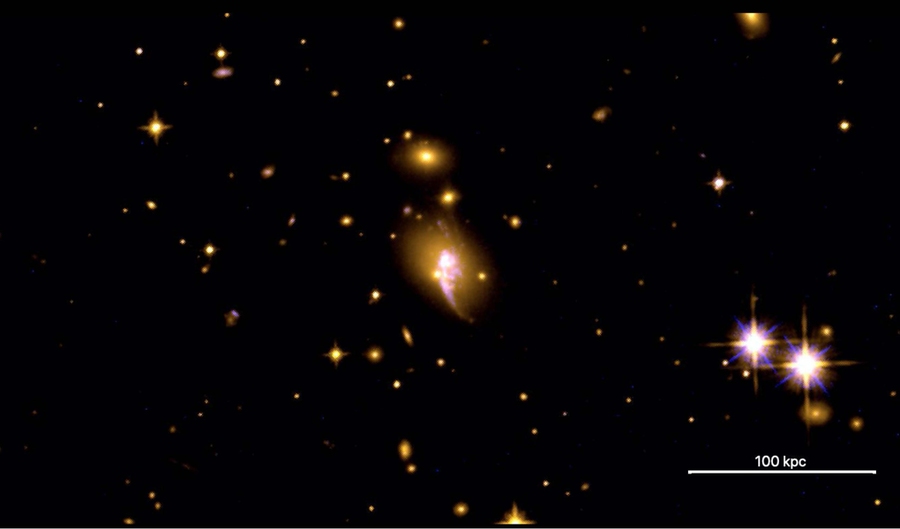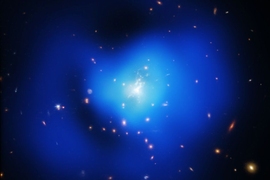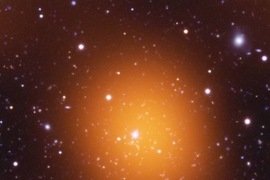MIT astronomers have discovered new and unusual galactic neighborhoods that previous studies overlooked. Their results, published today, suggest that roughly 1 percent of galaxy clusters look atypical and can be easily misidentified as a single bright galaxy. As researchers launch new cluster-hunting telescopes, they must heed these findings or risk having an incomplete picture of the universe.
Galaxy clusters contain hundreds to thousands of galaxies bound together by gravity. They move through a hot soup of gas called the intracluster medium, which contains more mass than all the stars in all the galaxies within it. This hot gas fuels star formation as it cools and emits X-ray radiation that we can observe with space-based telescopes.
This bright gas cloud creates a fuzzy halo of X-rays around galaxy clusters, making them stand out from more discrete point sources of X-rays produced by, for example, a star or quasar. However, some galactic neighborhoods break this mold, as MIT Associate Professor Michael McDonald learned nine years ago.
In 2012, McDonald discovered a cluster unlike any other, which shone bright like a point source in the X-ray. Its central galaxy hosts a ravenous black hole that consumes matter and spews X-rays so bright as to drown out the diffuse radiation of the intracluster medium. In its core, the cluster forms stars at a rate roughly 500 times higher than most other clusters, giving it the blue glow of a young star population instead of the typical red hue of aging stars.
“We’d been looking for a system like this for decades,” McDonald says of the Phoenix cluster. And yet, it had been observed and passed over years prior, assumed to be a single galaxy instead of a cluster. “It’d been in the archive for decades and no one saw it. They were looking past it because it didn’t look right.”
And so, McDonald wondered, what other unusual clusters might be lurking in the archive, waiting to be found? Thus, the Clusters Hiding in Plain Sight (CHiPS) survey was born.
Taweewat Somboonpanyakul, a graduate student in McDonald’s lab, devoted his entire PhD to the CHiPS survey. He began by selecting potential cluster candidates from decades of X-ray observations. He used existing data from ground-based telescopes in Hawaii and New Mexico, and visited the Magellan telescopes in Chile to take new images of the remaining sources, hunting for neighboring galaxies that would reveal a cluster. In the most promising cases, he zoomed in with higher-resolution telescopes such as the space-based Chandra X-Ray Observatory and Hubble Space Telescope.
After six years, the CHiPS survey has now come to a close. Today in The Astrophysical Journal, Somboonpanyakul published the survey’s cumulative results, which include the discovery of three new galaxy clusters. One of these clusters, CHIPS1911+4455, is similar to the rapidly-star-forming Phoenix cluster and was described in a paper in January in The Astrophysical Journal Letters. It’s an exciting finding since astronomers know of just a few other Phoenix-like clusters. This cluster invites further study, however, as it has a twisted shape with two extended arms, whereas all other rapidly-cooling clusters are circular. The researchers believe it may have collided with a smaller galaxy cluster. “It’s super unique compared to all the galaxy clusters that we now know,” says Somboonpanyakul.
In all, the CHiPS survey revealed that older X-ray surveys missed roughly 1 percent of galactic neighborhoods because they look different than the typical cluster. This can have significant implications, since astronomers study galaxy clusters to learn about how the universe expands and evolves. “We need to find all the clusters to get those things right,” McDonald explains. “Ninety-nine percent completion isn't enough if you want to push the frontier.”
As scientists discover and study more of these unusual galaxy clusters, they may better understand how they fit into the broader cosmic picture. At this point, they don’t know whether a small number of clusters are always in this strange, Phoenix-like state, or if this is perhaps a typical phase that all clusters undergo for a short period of time — roughly 20 million years, a fleeting moment by spacetime standards. It’s difficult for astronomers to tell the difference, as they only get a single snapshot of each cluster nearly frozen in time. But with more data, they can make better models of the physics governing these galactic neighborhoods.
The conclusion of the CHiPS survey coincides with the launch of a new X-ray telescope, eROSITA, which aims to grow our catalogue of clusters from a few hundred to tens of thousands. But unless they change the way they look for those clusters, they will miss hundreds that deviate from the norm. “The people that are building out the cluster searches for this new X-ray telescope need to be aware of this work,” says McDonald. “If you miss 1 percent of the clusters, there's a fundamental limit to how well you can understand the universe.”
This research was supported, in part, by the Kavli Research Investment Fund at MIT, and by NASA through the Guest Observer programs for the Chandra X-ray Observatory and Hubble Space Telescope.








